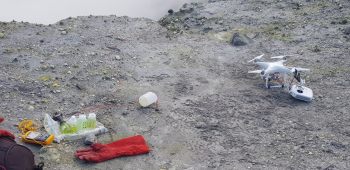
Sampling the inaccessible: A drone at work on Whakaari/White Island
Last month volcano monitoring staff used a drone, or UAV (unmanned aerial vehicle) to collect water samples from Whakaari/White Island’s Crater Lake, enabling the team to take the pulse of the volcano in a unique way.
Whakaari/White Island is New Zealand’s most active volcano and the most extreme environment where our staff work. The volcano’s Crater Lake is a witch’s brew of bubbling, hot and acidic fluid that is far more acidic than battery acid. It has a lake temperature of around 60-70C with a pH of around -1.0 (yes, a negative pH).
When we can, we collect samples by filling containers manually, but conditions on our last visit made it impossible to approach the lake safely. So, we used a drone to take the sample for us. Here it is in action:
While we regularly use UAVs for monitoring, this is the first time we used one to collect samples. The steam and wave action in the lake created many challenges for our team, not to mention the pilots had to be positioned 25 metres above the actual lake.
The sampling device itself was simple 'kiwi' ingenuity, thanks to our clever technicians. It needed to be light, something that wouldn’t react with the water or contaminate the sample, and be easy to see from 150-200 metres distance. They got to work and using string and a dismembered sample bottle, produced our successful sampling tool.
Understanding the chemistry of the crater lake plays a crucial role in interpreting the changes occurring on the island. This new technique could open new possibilities for the future, enabling us to collect the data we need, while keeping our staff safe.
Attributable to: Geoff Kilgour, Brad Scott - GNS Science Volcanologists
Media Contact: Brad Scott - 07 374 8211

